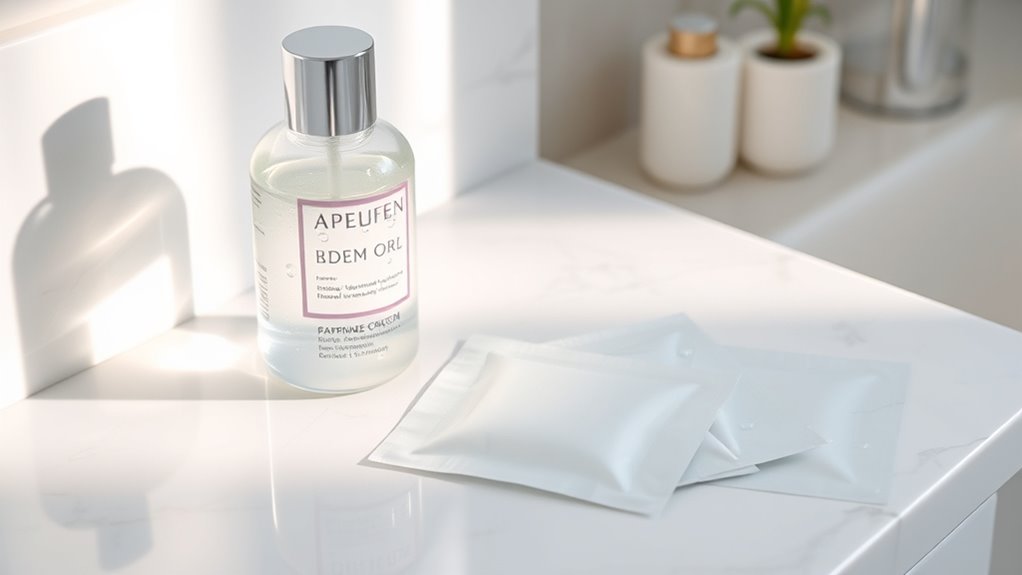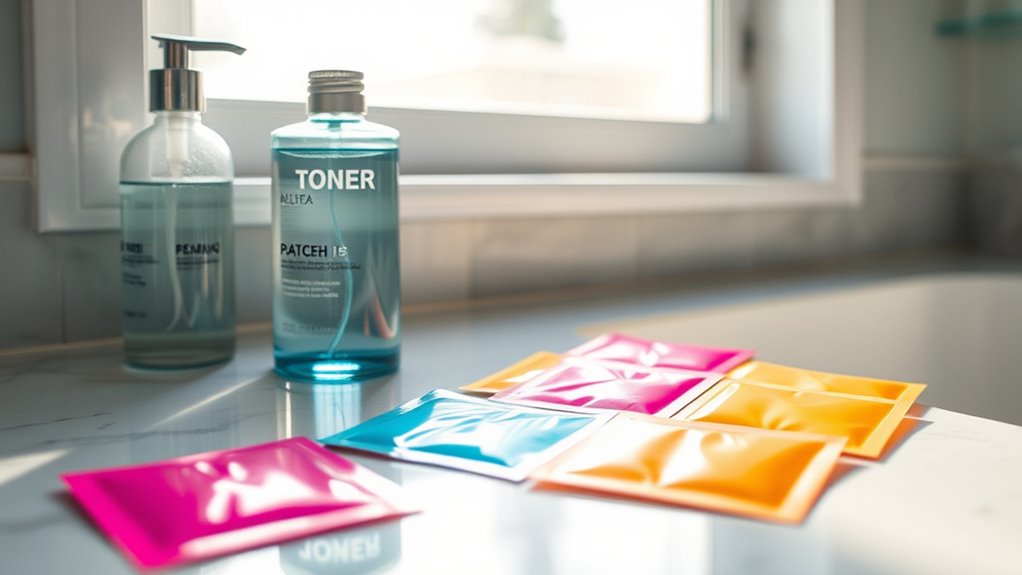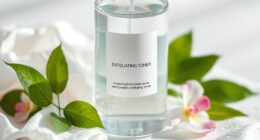Applying pimple patches after toner can be beneficial, as toners help to cleanse and prep your skin for treatment. However, make sure your skin is clean and dry before placing the patch. Choose the right size to cover the blemish, and avoid using them on irritated or broken skin. While they work best on surface pimples, there are other options if you have deeper issues. Stick around to discover more about maximizing your skincare routine!
Key Takeaways
- Applying pimple patches after toner can be effective, as toners help prepare the skin for treatment by removing residual impurities.
- Ensure your skin is completely dry after applying toner to allow the patch to adhere properly for maximum effectiveness.
- Avoid using pimple patches on inflamed or broken skin; they are best for surface blemishes.
- Consider your skin type; certain toners may enhance patch efficacy, while others could cause irritation.
- If using active treatments, like salicylic acid, consider applying them separately before patches for targeted acne care.
Understanding Pimple Patches

Pimple patches are a popular solution for tackling pesky breakouts. These patches, primarily made from hydrocolloid material, create a moist healing environment that promotes recovery. They often feature a polyurethane film on the outer layer, protecting your skin from bacteria and infection. Some patches include active ingredients like salicylic acid or tea tree oil to target specific acne causes. By absorbing impurities and excess oil, they reduce pimple size and inflammation effectively. Plus, they prevent you from picking at your pimples, minimizing the risk of irritation and scarring. While they work best on surface-level breakouts, hydrocolloid patches have also been shown to be effective in reducing the severity of acne when used properly. Consider combining them with other treatments for a thorough approach to your skincare routine.
The Role of Toners in Skincare

Toners play an essential role in your skincare routine, especially after cleansing, as they help restore your skin’s natural pH balance. They effectively remove residual dirt, oil, and makeup that your cleanser may have missed, ensuring a clean canvas. Toners can also temporarily tightens skin and reduces pore size, making them a valuable addition for those looking to improve skin texture. Additionally, using a toner with 7% glycolic acid can enhance skin hydration and moisture retention.
Many toners also contain hydrating ingredients like hyaluronic acid to keep your skin moist and ready for subsequent products. If you have oily skin, toners with astringents like witch hazel can control excess oil, while hydrating toners soothe dry skin. For acne-prone skin, those with salicylic acid can help clear breakouts.
Best Practices for Applying Pimple Patches

Applying pimple patches effectively can greatly enhance their benefits, so following a few best practices is crucial.
Start by cleansing your face with a gentle cleanser, then make certain your skin is completely dry. Choose the right patch, preferably one infused with salicylic acid or tea tree oil, and select a size that covers the pimple and surrounding area. Pimple patches are adhesive stickers designed for targeted, convenient, and discreet treatment of breakouts.
Cleanse your face and ensure it’s dry before choosing the right pimple patch for effective treatment.
When placing the patch, adhere it firmly without air bubbles and hold it in place for 20 to 30 seconds. For maximum effect, leave the patch on for at least 6 hours or overnight.
Avoid using it on inflamed or broken skin, and remove the patch once it turns opaque or after the recommended duration.
Alternatives to Applying After Toner

While pimple patches are a popular choice for treating breakouts after applying toner, several effective alternatives can also help manage acne. Hydrocolloid patches work wonders on surface-level pimples by absorbing excess fluid and preventing you from picking at them. For early-stage breakouts, salicylic acid treatments unclog pores and reduce inflammation, though they can cause dryness. Benzoyl peroxide treatments target more developed pimples by killing acne-causing bacteria but should be used sparingly to avoid irritation. If you’re dealing with deeper cystic acne, microneedling patches deliver potent ingredients directly into the skin. Finally, incorporating exfoliating routines with AHAs or BHAs promotes cell turnover, keeping your skin clear and healthy. Writing can help interpret or analyze subjects for better understanding, so choose what suits your skin best!
Common Mistakes With Pimple Patches

When using pimple patches, it’s easy to make common mistakes that can hinder their effectiveness. First, make sure your skin is clean and dry before applying the patch. Applying to irritated or broken skin can worsen your acne and introduce bacteria. Remember, pimple patches aren’t effective for deeper pimples like cystic acne; they work best on surface-level blemishes. Additionally, hydrocolloid patches are ideal for whiteheads, while those with salicylic acid help exfoliate and unclog pores. Also, choose the right size patch to match your pimple for best results. If you have sensitive skin, opt for hypoallergenic materials to avoid irritation. Avoid applying patches to already red or sensitive areas to prevent further discomfort.
Making the Right Choice for Your Skin

Choosing the right pimple patch can greatly enhance your skincare routine and help manage breakouts effectively. Apply patches on clean, dry skin immediately after cleansing for best results. Hydrocolloid patches are perfect for surface-level pimples, while medicated patches with salicylic acid target inflamed spots. If you’re dealing with deeper cystic acne, consider microneedling patches for deeper delivery of active ingredients. Patches come in various sizes, so select one that fits your pimple for effective coverage. Hydrocolloid patches are also designed to absorb excess fluid and reduce redness while protecting the area. Opt for ultra-thin, transparent options if you plan on wearing makeup during the day. Remember to wash your hands before application and avoid touching the patch once it’s on, ensuring you maximize its healing potential while preventing further irritation.
Frequently Asked Questions
Can I Use Pimple Patches on Cystic Acne?
You shouldn’t use pimple patches on cystic acne.
These patches work best on surface-level pimples like whiteheads, and cystic acne lies deeper in the skin. They won’t penetrate far enough to be effective and might even irritate your skin further.
Instead, consider professional treatments or topical solutions like salicylic acid.
Focusing on a balanced skincare routine will help you tackle cystic acne more effectively in the long run.
How Do I Know When to Remove a Pimple Patch?
You’ll know it’s time to remove a pimple patch when it turns opaque or has absorbed impurities, forming a white spot.
Typically, this takes about 4-8 hours, but for stubborn spots, you can leave it on overnight.
If the patch feels loose or starts to peel off naturally, it’s also a sign it’s done its job.
Gently peel it off to avoid irritating your skin, then clean and dry the area afterward.
Can Pimple Patches Be Reused?
You might think about giving those little acne warriors a second chance, but alas, they’re not meant for a repeat performance.
Once used, they’ve absorbed the not-so-lovely stuff from your skin, making them less effective. Plus, reusing them can invite unwanted bacteria, potentially leading to more trouble.
For the best results, it’s wiser to discard them and stick with a fresh patch—your skin will thank you!
Are There Any Side Effects From Using Pimple Patches?
Yes, there can be side effects from using pimple patches.
You might experience redness or irritation, especially if you have sensitive skin. Allergic reactions to ingredients like latex or salicylic acid can occur too.
Sometimes, you’ll notice dryness or peeling, particularly with medicated patches. In rare cases, prolonged use could lead to blisters or delayed healing.
Always patch test and avoid using on broken skin to minimize potential reactions.
How Many Pimple Patches Can I Use at Once?
Funny how you’re worried about using too many pimple patches when you’ve probably tried every remedy under the sun!
There’s really no strict rule—use as many as you need based on your blemishes. Typically, apply one patch per pimple, but if you’re in a breakout battle, multiple patches can come to the rescue.
Just make sure your skin is clean and dry for the best adhesion and effectiveness. Your skin will thank you!
Conclusion
To sum up, using pimple patches after toner can be beneficial, but it really depends on your skin type. Did you know that about 50% of people experience acne at some point in their lives? That’s why it’s crucial to find what works best for you. If you notice that applying patches after toner helps with healing and reduces inflammation, then go for it! Just remember to avoid common mistakes to maximize their effectiveness and keep your skin happy.










